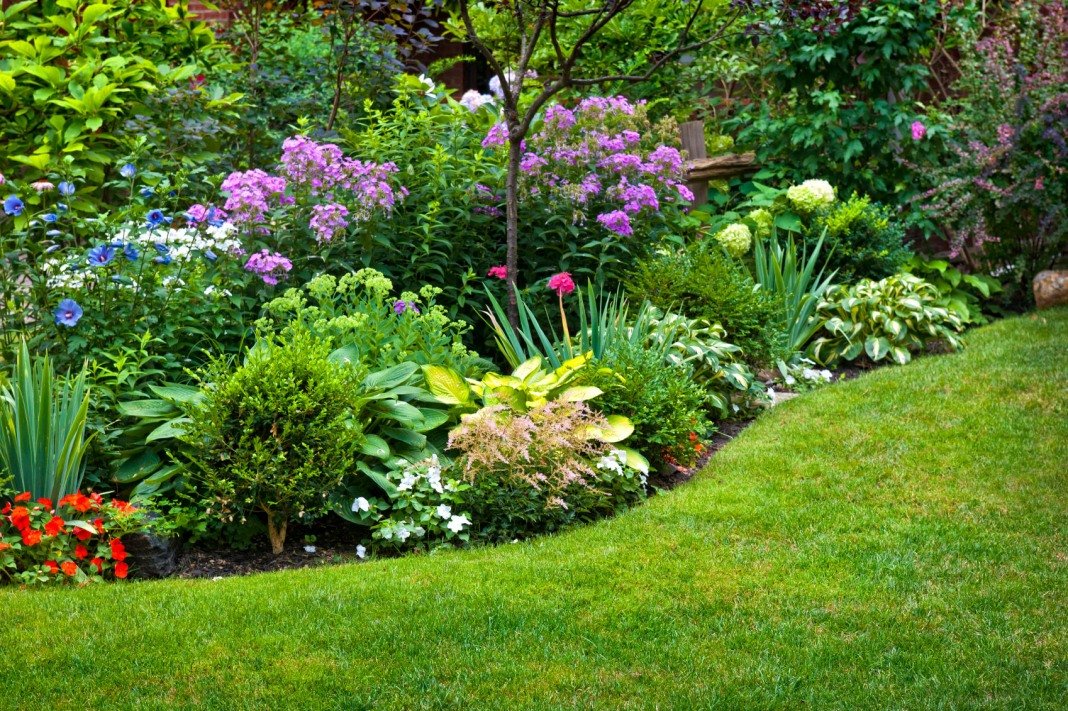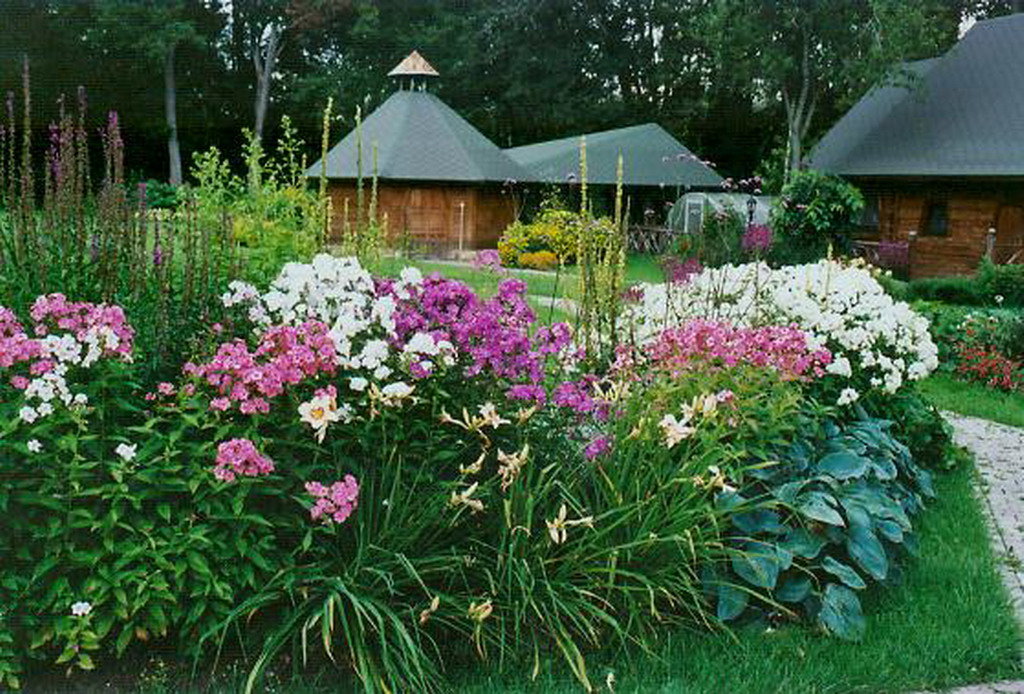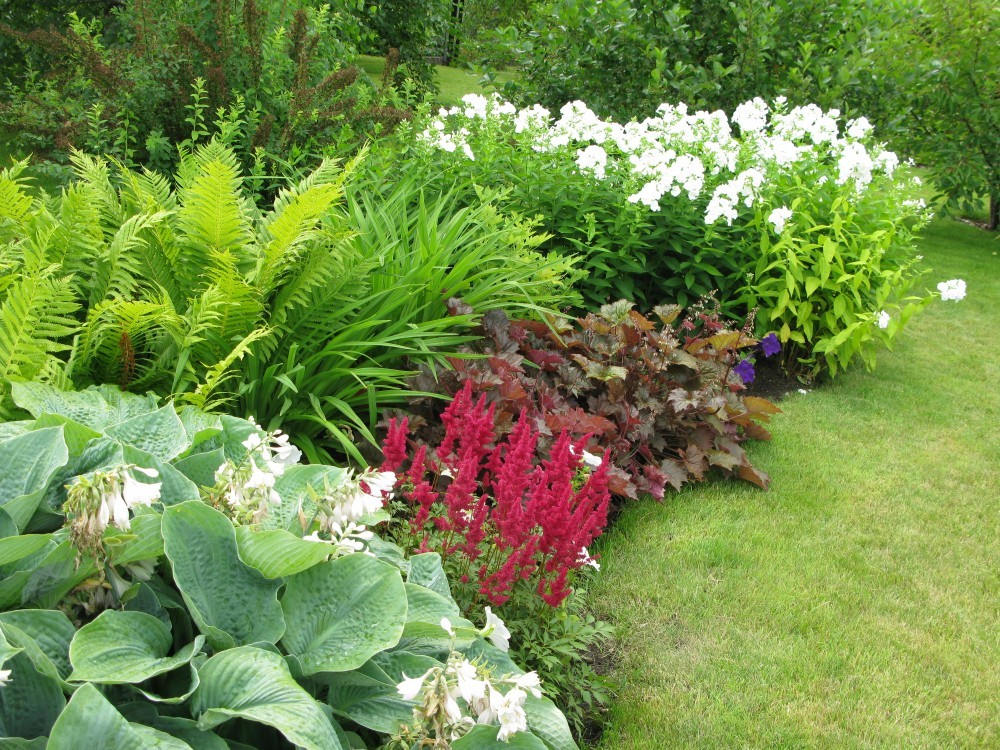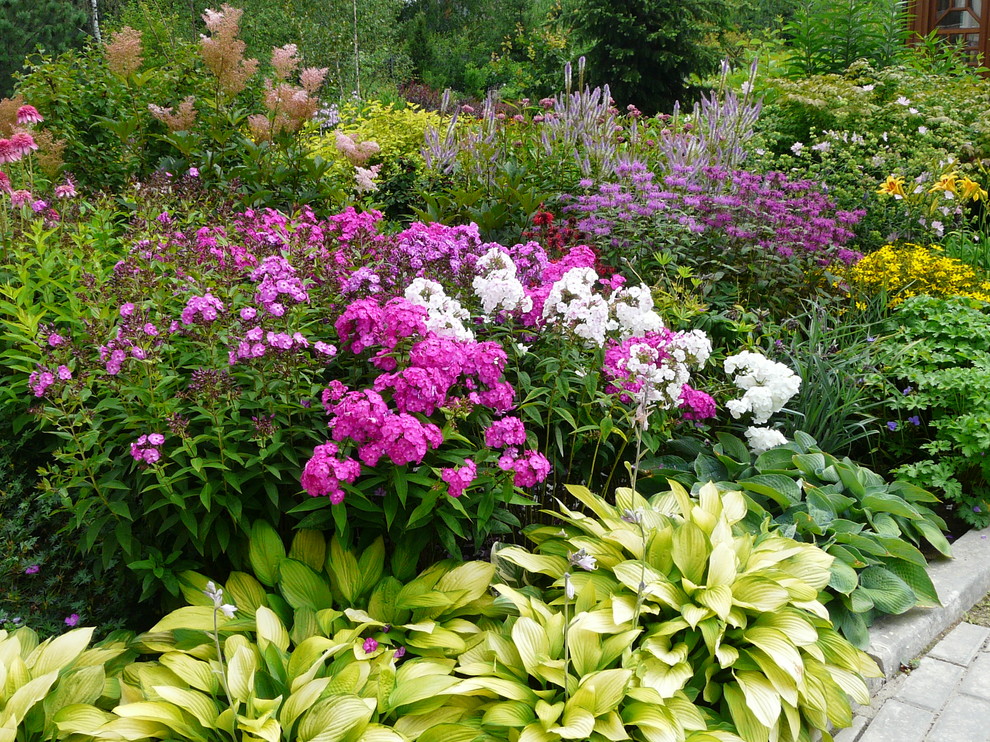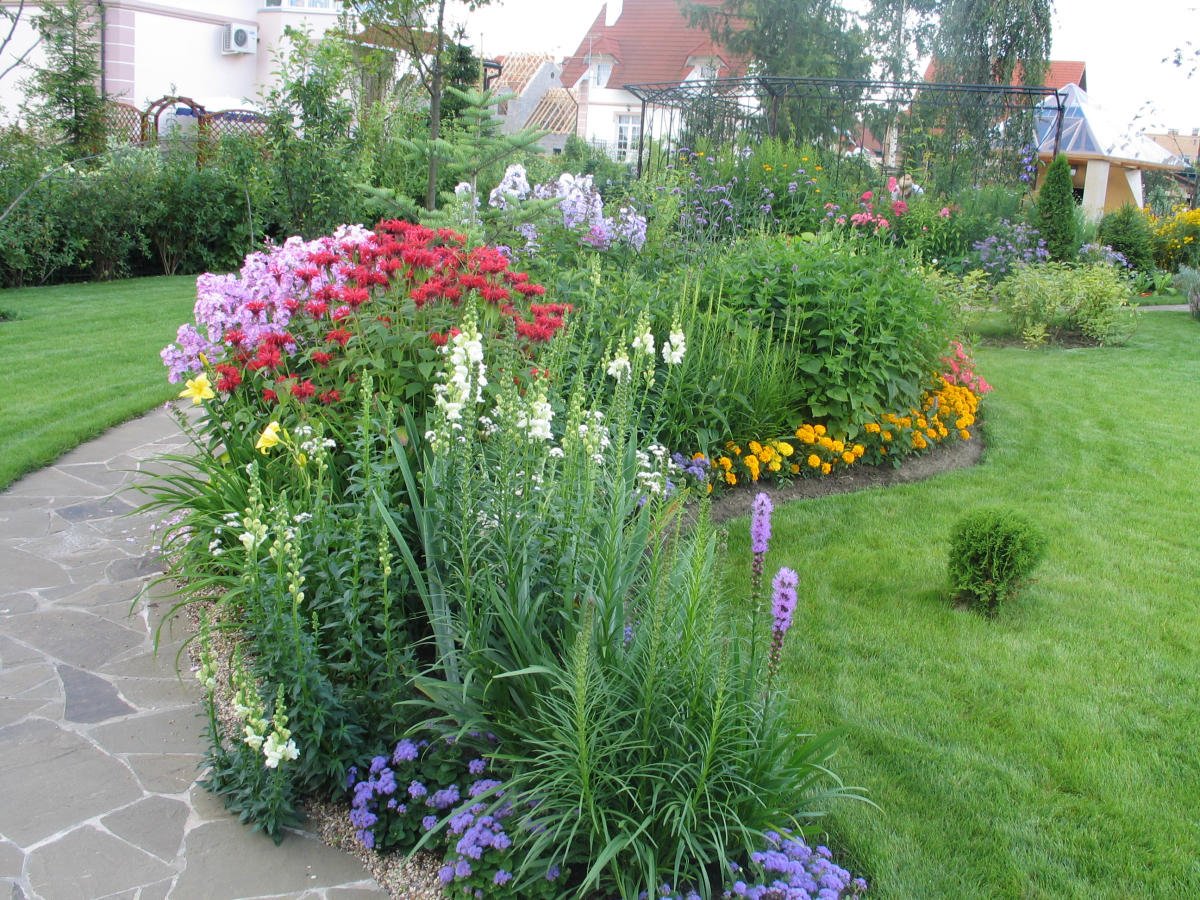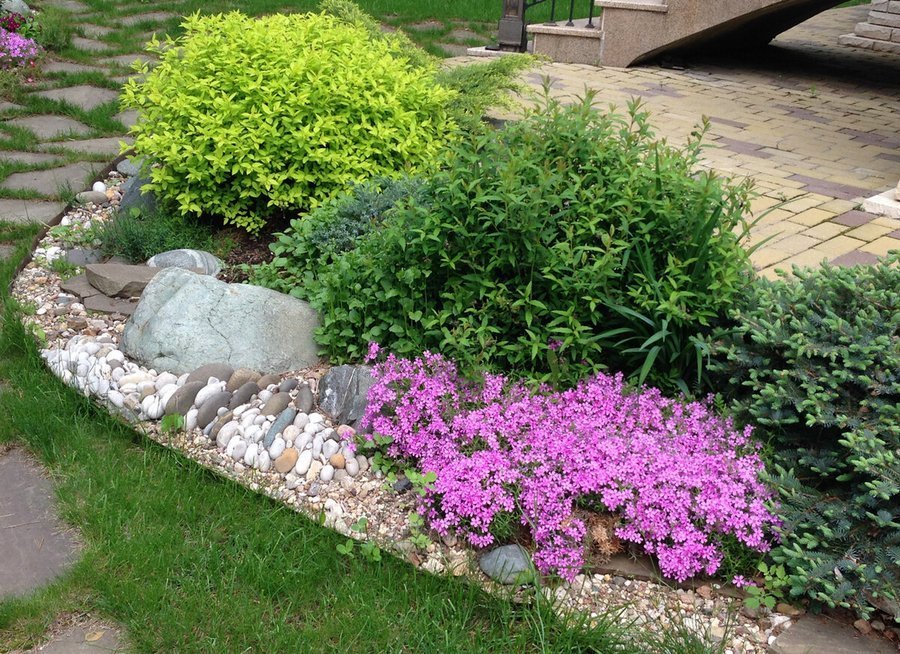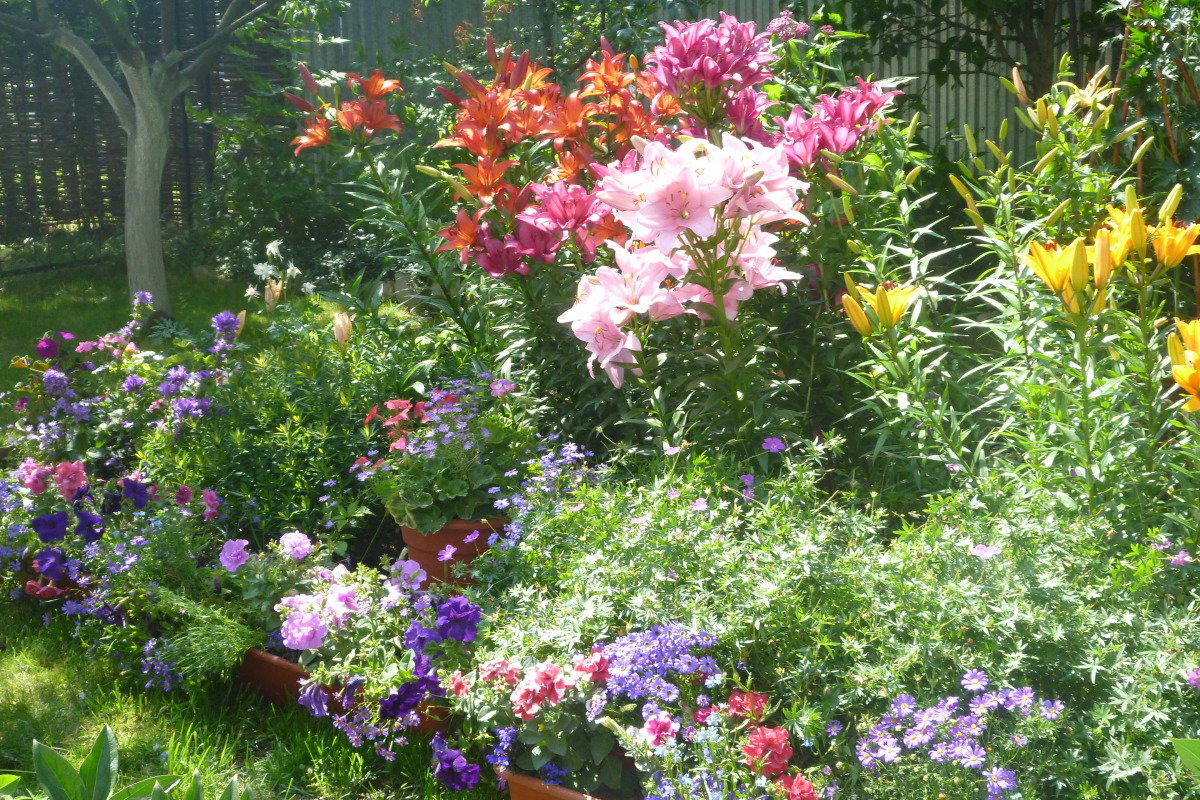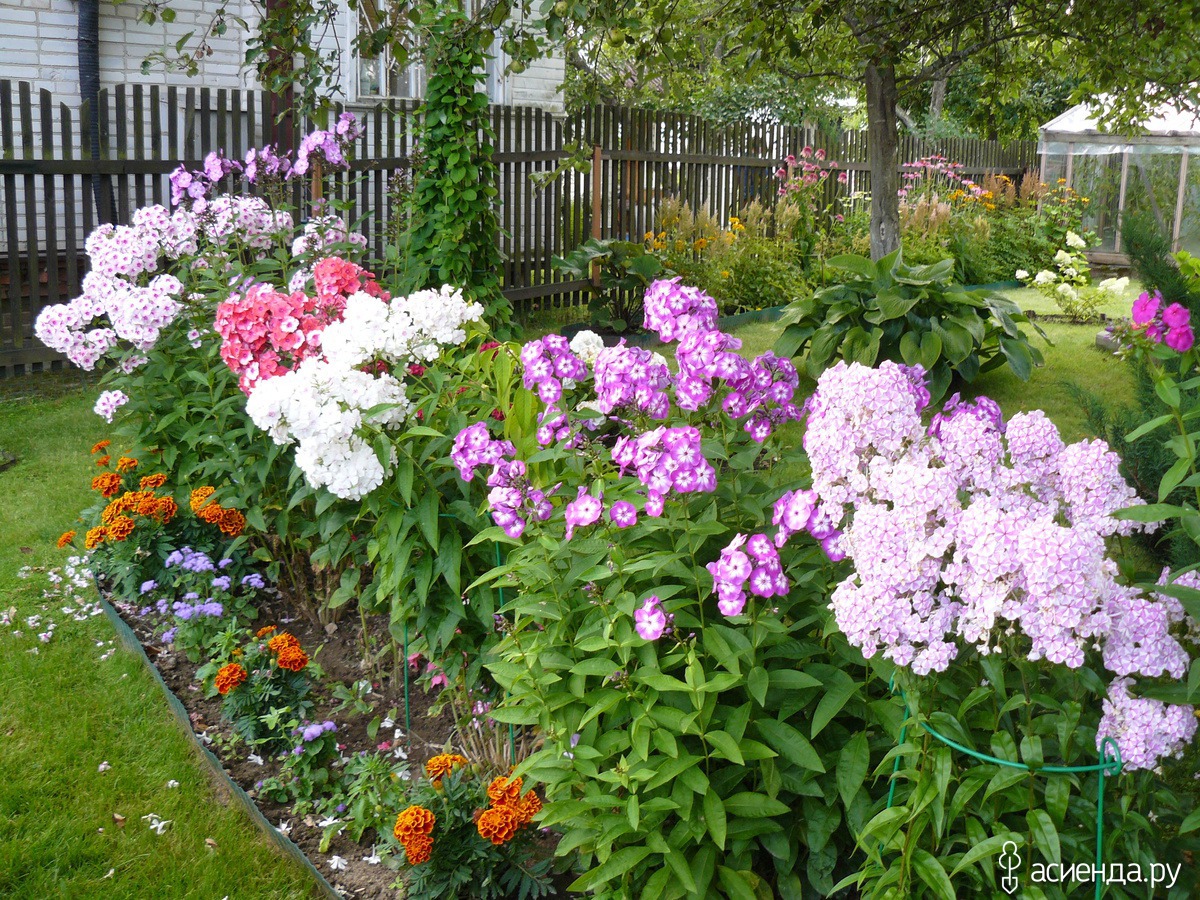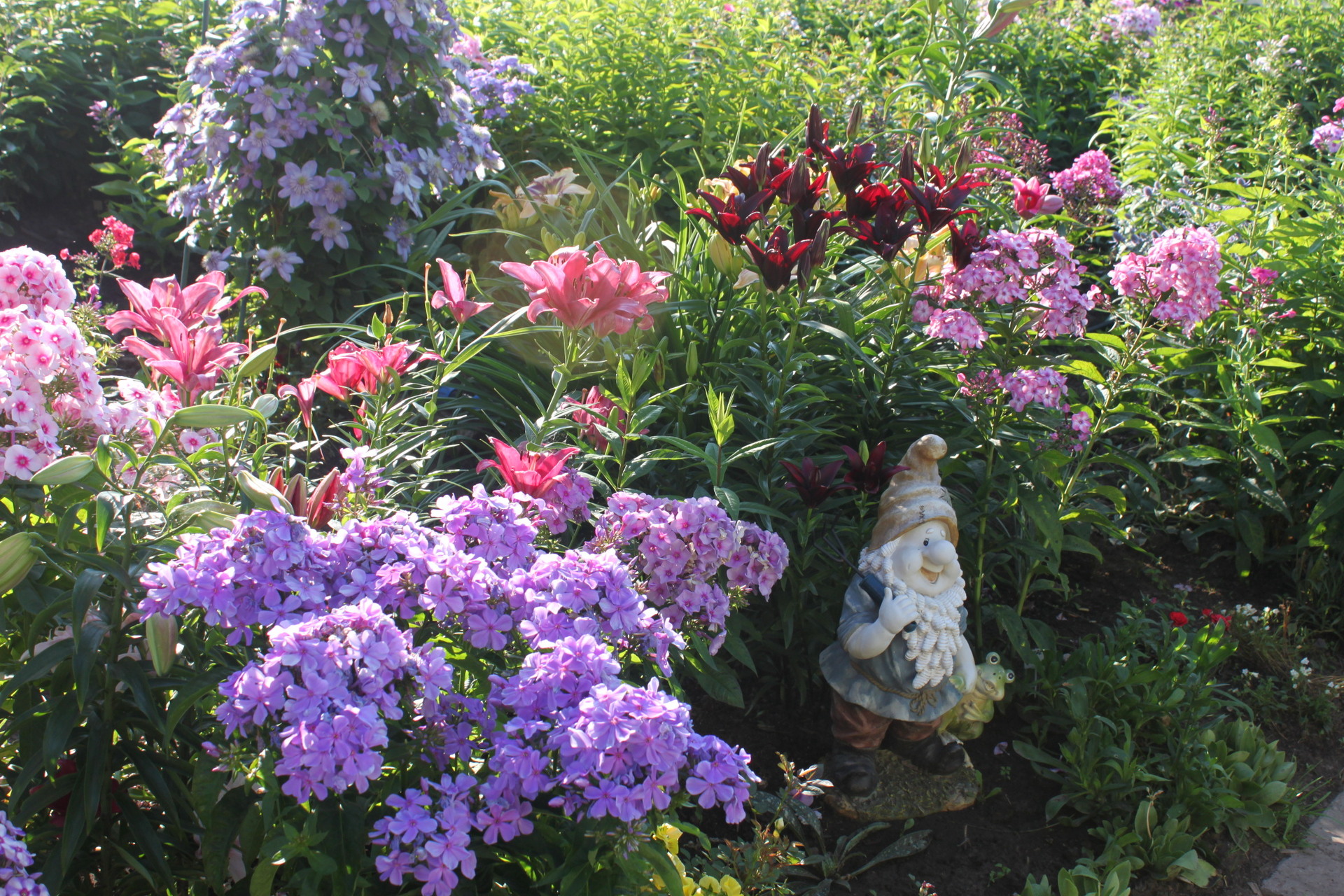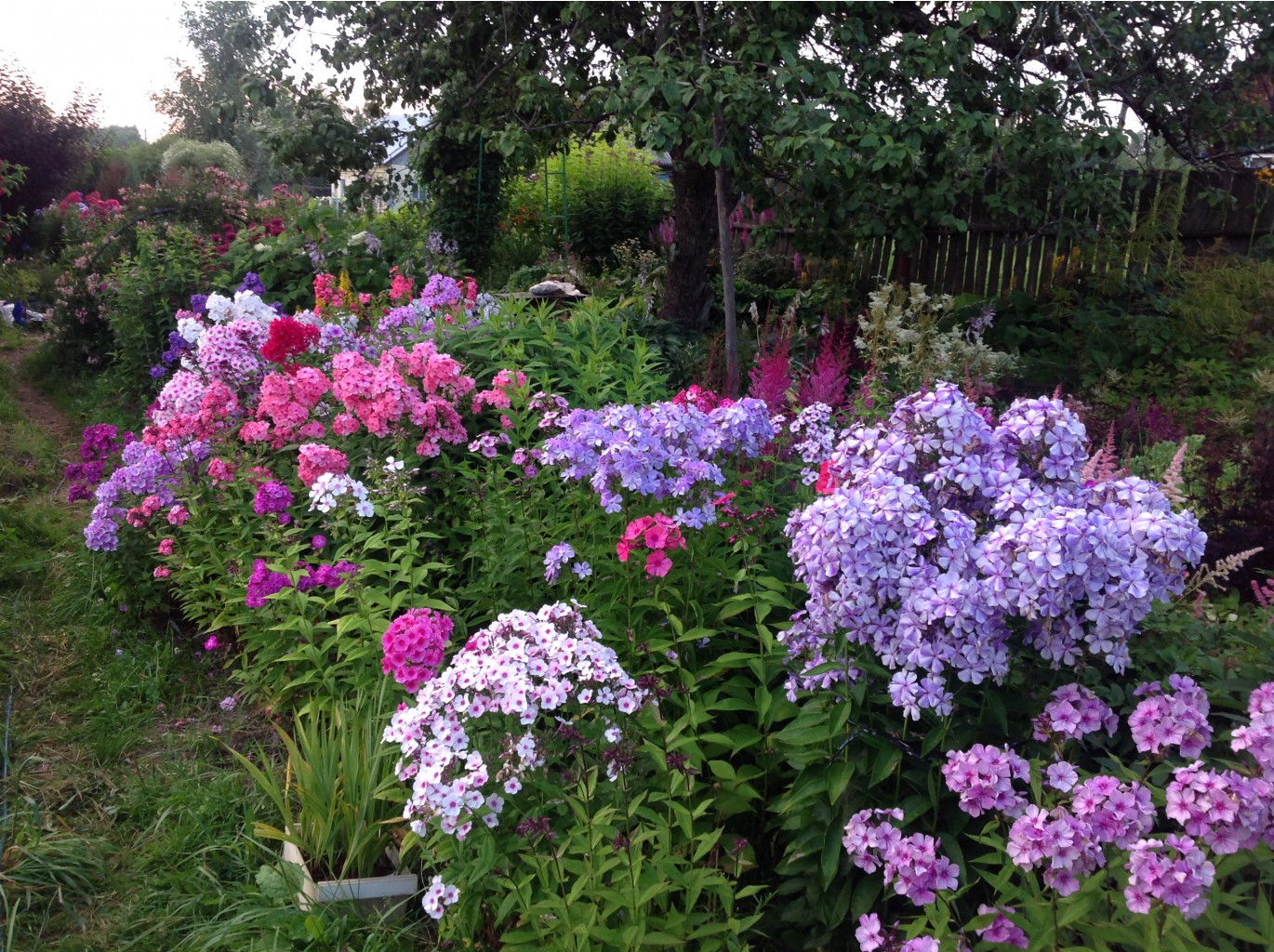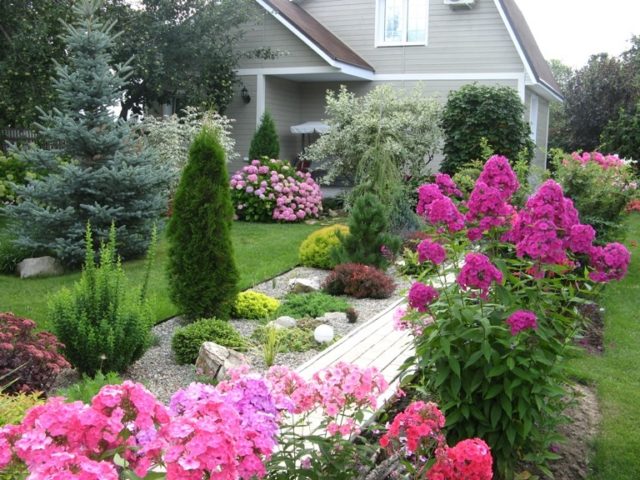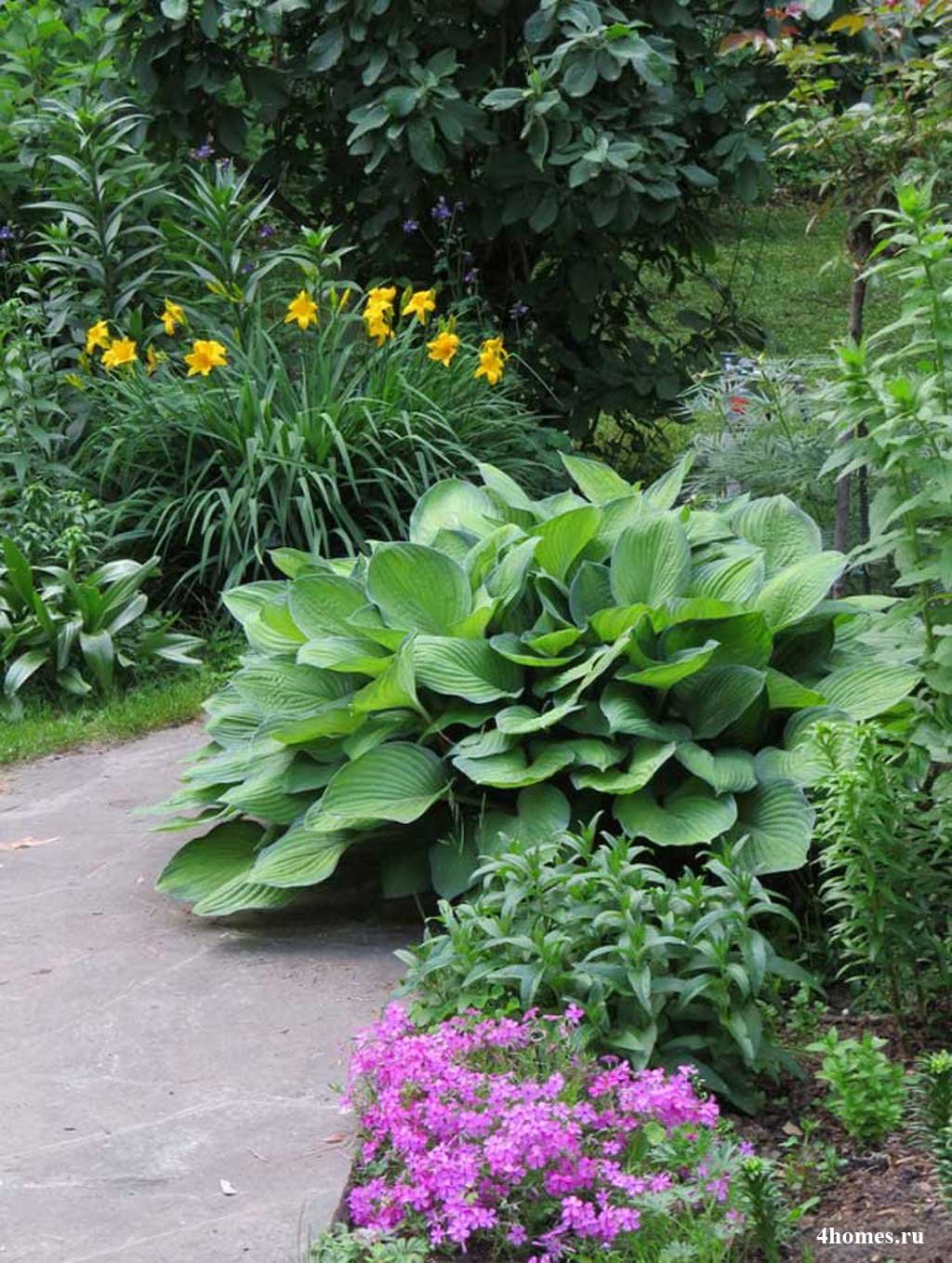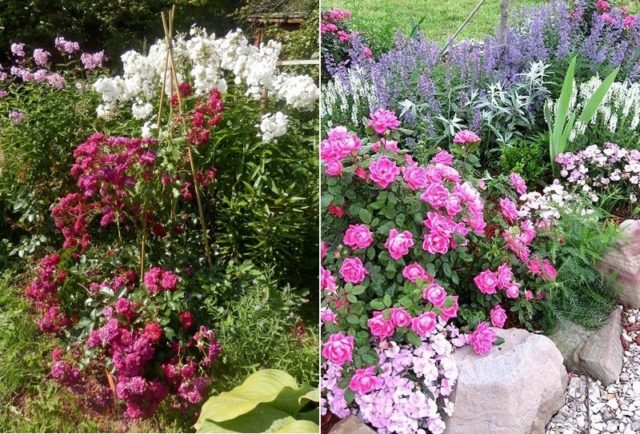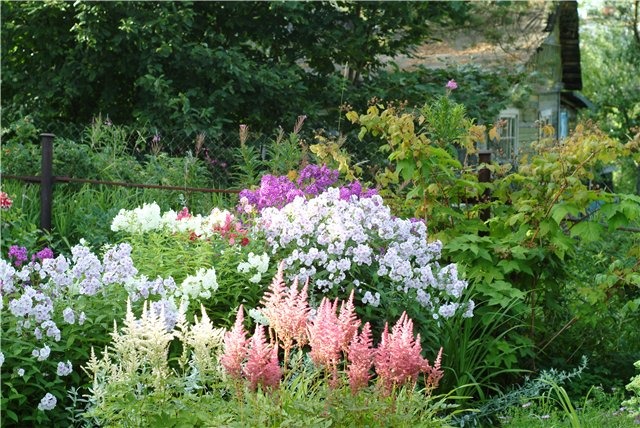Choice of colors
The color palette is rich and varied. However, in the composition of these plants, the yellow pigment is completely absent. Breeders all over the world have been trying for several centuries to develop a variety that has at least a faint shade of yellow. But all attempts end in failure. However, phlox are capable of pleasing the eye in all shades of red, purple and white.
Phlox are combined with flowers that have light, light shades. In this case, they become lush and airy. Shades the sophistication and aristocracy of the neighborhood with flowers of pale yellow, bluish and cream motifs.
Important! Dark, rich plant neighbors will add depth and sensuality to phlox
Irises in landscape design
An incredibly popular garden decoration with a delicate aroma, it is known all over the world. People conveyed their reverent attitude to the floral representative of the flora by the tender name "kasatik". Large buds grow on exquisite stems, framed by a luxurious fan of leaves. Flowers have been favorites with renowned artists such as Monet and Van Gogh. A perennial sun-loving plant native to southern countries. Its unpretentiousness, decorativeness and a huge variety of shapes, shades, and varieties make iris a welcome guest in any style of landscape design.
The flowering period does not last long, but the plant retains its decorative effect even after it. Some species begin to bloom in May, others in June. The plant takes almost no time to care for the gardener, while giving a beautiful, delicate look and aroma. The flower is universal: it is used in almost all garden compositions, group and single plantings. He is a wonderful "neighbor", gets along well and blends with many cultures. The plant is conventionally divided into three groups:
- dwarf (up to 45 cm). A popular element of alpine slides and rockeries;
- medium-sized (45-75 cm). Frequent "guest" in group landings;
- tall (75 cm and more). Wonderful decoration of the shores of reservoirs.
Irises fill with their beauty the free period of time between the blooming of spring and summer flowers. This is a real rainbow in the garden! Proud and graceful beauty can turn the most gray and nondescript corner into a heavenly place.
What types of irises are there, and how are they different?
The cultivated varieties are grouped into two large groups:
-
Bearded irises are easily recognizable by the hairs on the inner surface of the outer petals of the buds. The hairs are clearly visible; at the place of the bend of the petal plate, they resemble a protruding beard.
-
The beardless are not so graceful. A characteristic feature is yellow spots of various sizes on the middle part of the bud.
Groups differ not only in appearance, but also in agricultural technology. Bearded varieties are drought-resistant. Beardless people love wet land, quickly adapt near water bodies, in low-lying places.
Irises spuria and Japanese in garden decoration
The extravagance of some irises in landscaping deserves respect. Spuria surprise with the freshness of xiphoid greenery, flowers that rival orchids in tenderness. Among the different varieties of spuria, the xiridion or Japanese are considered the most common. The flower blooms almost a month later than its bearded relatives. Flowering lasts more than a week. Irises do not wither in bouquets; they are often grown for cutting.

Iris spuria - Clara Ellen cultivar
Any spuria can be used to decorate ridges, borders, mixborders. Plants are used for combined relay plantings of all-season flowering.
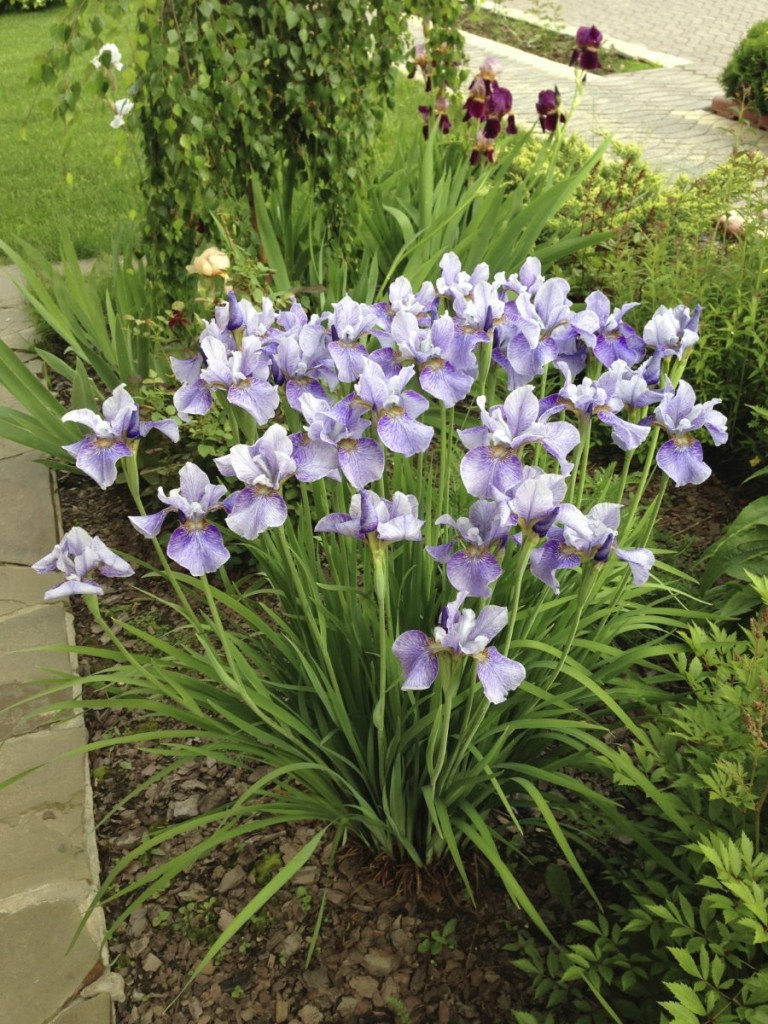
Japanese iris winters well in the climatic conditions of the Moscow region
Representatives of this look great in landscape ensembles, create a green background during the rest.
Siberian irises in garden decoration
The beardless moisture-loving varieties and hybrids are prized by designers for their refined sophistication. Siberian irises in garden design fascinate, attract the eye. Breeders create collections based on three types of irises:
- Siberian, found in mid-latitudes;
- blood-red, the original name of the species is "eastern iris";
- cattle, producing a large number of flowering arrows.
The flowers of Siberian irises are smaller than those of their bearded counterparts, but there are much more buds on the bush. All hybrids are resistant to diseases, undemanding to the composition of the soil, and adapt well to various climatic conditions.

Siberian irises are taken not by the size of flowers, but by their number

Siberian iris - grade Alba

Siberian iris - Rio Rita variety
In hybrids, the buds open in different ways. Some varieties are characterized by massive flowering - all arrows bloom at the same time, others - sequentially. The longest flowering period is in white and lavender irises with branching peduncles.
Varieties of different growth heights
From garden irises, picturesque iridariums are created, combining various colors, varying the height of the plants. Group plantings are made, visible voids are filled with fine gravel or pebbles. The free space fills up as the bushes grow, the compositions retain their attractiveness for decades.

Tall irises along a wooden fence
In light of the latest trends, designers recommend planting irises of different varieties not linearly, but asymmetrically, like on an alpine slide, so that there are no clear boundaries.
When compiling rockeries, flower arrangements, the height of the plants is taken into account. Irises are conventionally divided into three growth units:
-
dwarf species that grow up to 25 cm are considered to be undersized, limited to a height of 40 cm (plants are used for border plantings, on alpine slides, in rockeries);
-
the height of medium-sized species varies from 40 to 70 cm (such iris are appropriate in mixed compositions with conifers, perennials blooming in late autumn);
-
tall irises up to 1.5 meters in height look great in a single planting, on the banks of water bodies.
Beardless irises cannot be combined with perennials with a fibrous root system. The fast growing roots will displace the irises in a short period of time.
Planting rules, descriptions and schemes of flower beds
A properly selected place for planting perennial phlox in a flower bed should not be in direct sunlight, especially at noon. This causes the petals and leaves to burn out. It is best to plant them near trees or bushes to protect them from the sun and wind. It is not advisable to build such a flower bed on the north side of the site.

Since the varieties of this flower are undersized (60 cm) or tall (up to 170 cm), they should be planted, taking into account this fact. Small varieties should be planted along the perimeter of the flower bed, while for tall ones it is better to choose a place near the fence or in the corner of the flower arrangement. The tallest plants can be placed in the central part, and small ones along the edges.
Flowerbeds can be built in the following schemes:
- Multilevel flower bed. Its principle is to plant tall flowers in the center of the composition, and along the edge of plants with smaller stems.
- Carpet flower bed. Its peculiarity is the selection of low-growing flowers with abundant flowering and the most dense planting, so that the appearance of a carpet is created.
- Curly flower beds: heart-shaped, islands, flower-shaped. In such compositions, low-growing flowers or with medium-sized stems are used. If plants with tall stems are also used for this, they will spoil the appearance of the clubs.
- Curb club.In the territories of personal plots and gardens, paths are created that can be revived by a variation of the bright outlines of flower plants.
Flowerbed with peonies and phlox
Peonies place high demands on their neighbors. But peonies and phloxes in the same flower bed, they can create an original atmosphere. The fact that peonies have different colors will allow them to be widely used in landscape design. A flower bed with peonies and phloxes should be created in such a way that their height is small and does not cover the lush flowering of peonies.
Flowerbed with daylily and phlox
Daylilies are the best suited for landscaping. Combines them with many other colors. They retain their decorative appearance until late autumn. When choosing plants adjacent to daylilies, you should carefully select their shades. For example, perennial phlox in a flower bed with daylilies of pink and fawn shades resembles the Paniculata variety, and the deep red daylilies are planted next to the Amethyst variety.
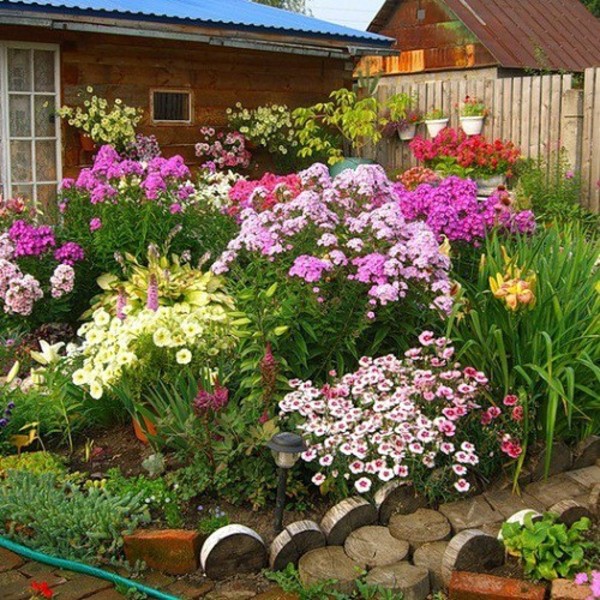
Flowerbed with phlox and other plants
Following the tips - what to combine phlox with when planting, you can create flower beds that will look good at any time of the season:
Phlox are successfully placed next to summer-autumn varieties:
For phlox blooming in spring, you can choose the following neighbors:
They are also used for planting near curbs, in rock gardens on lawns.
In order not to worry about the compatibility of shades, you can use varieties that bloom at different times on a flower garden with phlox.
These can be such plants:
Rules for drawing up flower arrangements
Visiting floristic exhibitions, people are amazed at the imagination and talent of the masters who create real masterpieces even from ordinary-looking plants. Composing an exquisite flower arrangement requires not only ability and inspiration, but also knowledge of the basic rules of floristry.
Before you start creating a flower bed, you need to draw or draw up a project in your mind, and based on it, perform a composition. A flower with a contrasting shade to the main background is usually chosen as the main point.
Imagining how a flower bed should look like, they divide it into 8 parts of the same size.
To make the composition look bright and interesting, plants of different heights and colors are used.
The bouquet seems weightless if light tones are combined, dark ones make it heavy and lush. To add harmony to the flower bed, you need to choose the right colors. The palette should be discreet, not flashy. The shades of the same paint are always successfully combined, contrasting tones look good in a certain sequence, starting with red and orange, and ending with blue, purple.
Top dressing for beautiful flowering
The flower garden should not be allowed to dry out. In hot weather, watering is required daily, in cool weather - 1-3 times a week. Top dressing for a flower bed with phlox should be applied only to wet soil. This is how the fertilizer is absorbed best. The most suitable times for feeding are before and after flowering.
Important! During the growing season, complementary foods are best cut down so as not to harm the inflorescences. Mineral and organic substances of natural origin are suitable as fertilizers.
You can also feed with combined fertilizers sold in specialized stores, they have different names, new types are provided every year. Therefore, the description should indicate that the fertilizers are suitable for phlox. The plant will benefit from mulching with ash. For the winter, it is recommended to cover the roots with nutritious soil.
Mineral and organic substances of natural origin are suitable as fertilizers. You can also feed with combined fertilizers sold in specialized stores, they have different names, new types are provided every year. Therefore, the description should indicate that the fertilizers are suitable for phlox.The plant will benefit from mulching with ash. It is recommended to cover the roots with nutritious soil for the winter.
To create a unique flower garden on a personal garden plot, it all depends on the scope and imagination of the gardener. A flowerbed with phlox, arranged in the local area, is unique in that it can be combined with any plants, and only benefit from it. In addition, phloxes are frost-resistant and rather unpretentious, so both experienced and novice gardeners can cope with them.
You need to know what phlox is combined with, and then they will create ideal compositions with roses, host, fern, gladioli, marigolds and other common flowers. The main thing in organizing a flower garden is to give freedom to desires and imaginations.
vote
Article Rating
How to achieve more effect
Having chosen the ideal partner for the paniculate phlox, try to diversify the color palette of phlox planted on the flower garden, enhancing the decorative effect of the composition. The variety of varieties of phlox paniculata is so great that it allows you to choose plants not only by the saturation of the tone, but also by the shape of the flowers and the nature of the color.
- Soft pink or spotted pink and white phlox look great with richer shades of pink, all the way to dark and very vibrant fuchsia.
- Light lilac, almost blue tones are perfectly combined with the brighter plants of the violet range growing nearby.
Planting phlox in ribbons, in groups, as borders or in a patterned, ornamental order, you can achieve completely unexpected effects, including optical illusions of increasing the depth of the flower garden or the internal glow of inflorescences. If the contrast with a neighboring plant seems too defiant to you, then the transition between different species can be softened by adding a more saturated color to the main phlox variety, which will play the role of a transitional step between the selected neighbors.
Features of caring for a flower garden
In order for irises to grow and develop normally, it is recommended to properly care for them. These flowers need sufficient light and moisture.
It is especially important to water the plants during the budding stage. Subsequently, it is worth moistening the soil only when it is completely dry at the roots.
Many gardeners are sure that flowers can hardly tolerate a transplant. However, in reality this is not the case. It is recommended to divide the bushes immediately after flowering. To do this, you should carefully dig out the roots so as not to damage them.
Timely weeding is also important. It is recommended to remove weeds manually
This is due to the structure of the root system - it is on the surface. It should be borne in mind that irises are susceptible to various diseases and pests. Therefore, it is worth monitoring the development of plants during the growing season. If signs of rot appear, it is recommended to get rid of the infected plant and spray the neighboring bushes with Fundazole solution. The same tool is recommended to process the rhizomes before planting. This will help minimize the risk of developing disease.
What can be a flowerbed with phlox (photo of plant planting options and flowering calendar)
Among all the varieties of phlox are:
- Creeping (ground cover) plants: This type of flowers begins to turn green and bloom very first - somewhere in the middle - towards the end of May (depending on the weather). In most cases, designers use it to create the background of a landscape composition, in which shrubs, other primroses, and fruit trees can participate. From creeping plant varieties, bright purple, juicy red, pink-white carpet flower beds, brook curbs, massifs and ridges are obtained. The unusual flower bed with phlox shown in the photo, the scheme of which has an irregular nature, is organized from the subulate type of flowers.It is ideal for alpine slides and single flower beds, decoration of retaining walls.
- Loose (spreading) plants. A transitional type of phlox, which no longer spreads on the ground, since it has a small (below average) stem length. It blooms after ground cover plant varieties and is considered the most unpretentious member of the family. And also exotic, because its inflorescences are a lush bunch of small flowers of light lilac, purple, lilac or white. Another advantage of the variety is the violet scent of flowers and the longest flowering period. It will help you evaluate how a phlox flower bed will look like, the photo below.
- Bushy undersized plants: This phlox variety blooms most of June and has a sweet scent. The stem of the flower does not exceed 100 cm in height, and the inflorescence consists of many small white, white-purple, deep red or dark pink flowers. These plants have one fundamental difference from their previous relatives. They love acidic soil. In it, they take root well and bloom violently. To organize a flower bed with phlox, a diagram is not needed. This plant variety looks great in a collage flower garden.
- Shrub tall plants. The most popular, extensive and well-known variety of phlox. Some representatives of the species bloom somewhere in mid-late June, others in early July, and still others in August. Their flowering lasts about a month. Tall plants have representatives with medium-sized and large, with spotted and outlandish flowers in the inflorescence. And also with an unusual inflorescence. This is how phlox flower beds can be - the photo was taken in the midst of flowering.
Compatibility of large irises with other plants
Garden irises are placed on the site, taking into account several nuances
It is recommended to pay close attention to the characteristics of specific varieties and species. It is recommended to plant the highest crops to create medium and long-range plant plans in landscape compositions.
Such varieties are organically combined with:
- junipers;
- evergreen thuja;
- barberries;
- forsythia;
- bladderworms;
- gray spireas.
Large varieties of these flowers, planted in the center of the lawn in a group, will look spectacular. Next to them, you can place paniculata phlox, daylilies, oriental poppies, hosts, badans.
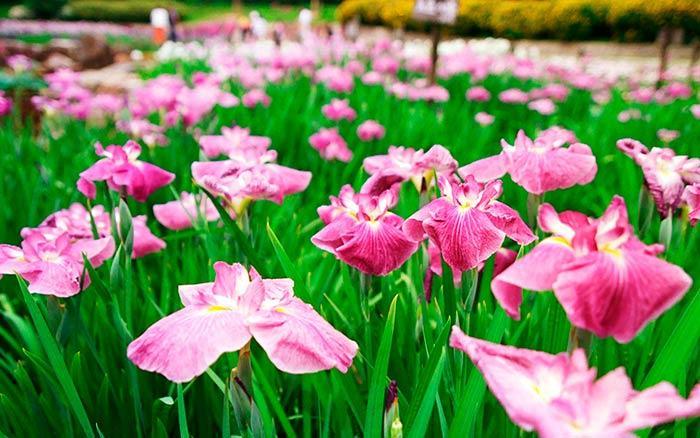
Effective combination of phlox with other colors
Many novice gardeners are wondering what to plant next to phlox. Before deciding which flowers to plant on a flower garden, you need to find out what kind of plant these or those plants belong to.
Ground cover flowers are best suited for decorating slides, wall decor and garden pots. For accentuating curbs, garden paths and dividing the garden into sections, it is best to give preference to low-growing plants.
Important! Tall specimens ideally decorate mixborders
Lilies and phloxes in one flowerbed
Lilies and phloxes in the same flowerbed are perfectly combined, but this does not apply to all species. Therefore, before you can beautifully plant phlox next to a lily, it is necessary to develop a certain scheme. Phloxes of blue and purple shades in combination with lilies look too colorful. A good background for the growing shoots of lilies are creeping varieties.
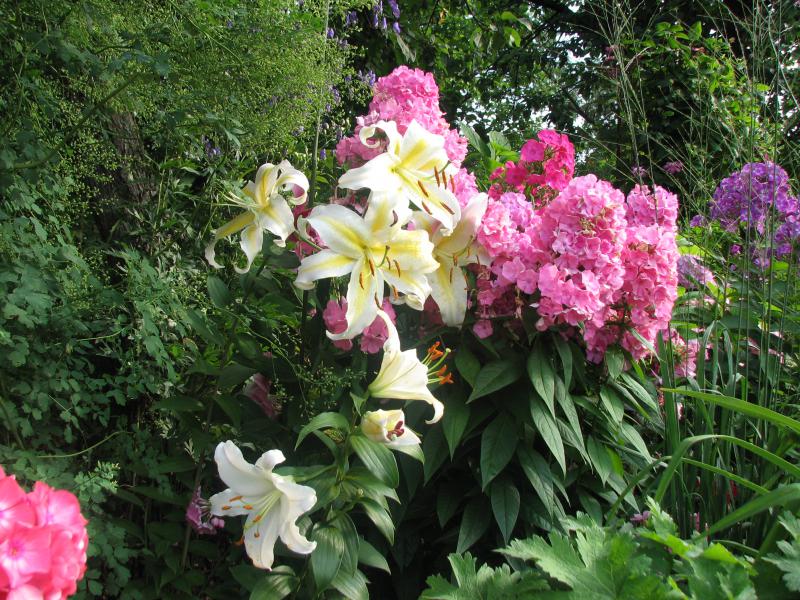
Lilies and phloxes in one flowerbed
With catnip
To emphasize the splendor and massiveness of the plant, you can plant a catnip next to it, which will seem completely weightless in this combination. The duet will be perfect not only in terms of color, but also textures, shapes and contours. It is best to combine pink-colored phlox varieties with catnip.
Due to the huge variety of phlox, which differ in color and height, all kinds of flowers can be used to decorate flower beds.At the same time, most often for planting, combinations of phloxes with hosts, roses, marigolds, gladioli, lilies, and ferns are used.
The use of phlox flowers in garden design (with photo)
Phlox are versatile plants. They have long gone beyond the grandmother's village front garden. Phlox can beautify modern gardens of almost any style, from country to regular. The use of phlox flowers in garden design is possible in an ordinary flower bed, in a mixborder, and in a flower garden bordering the path, and as an array on a lawn. Although when choosing phlox, few people manage to foresee all the details and not be mistaken, some points should still be borne in mind.
When choosing varieties, it is important to take into account the decorative features of phlox in the design of the garden, not only during flowering, but also throughout the growing season. Look at the photo of phlox flowers in the garden, which shows the most striking examples of the successful use of culture:
Look at the photo of phlox flowers in the garden, which shows the most striking examples of the successful use of culture:

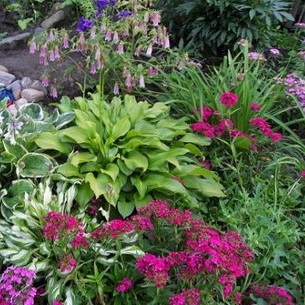
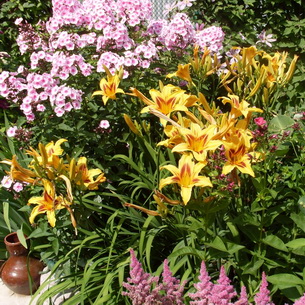

Phlox, large hosta and daylily. Such a trinity looks spectacular throughout the growing season. First, the hosta will be the soloist, then the daylily will be in the foreground, and the exuberant flowering of phlox will be the final chord. An additional charm of the composition is given by the combination of various forms of the leaves of these plants.
It must be remembered that lighting affects not only the development of phloxes. It can change the height of plants, the color tone of both leaves and flowers, and also shift the flowering time.
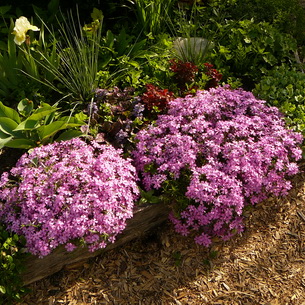
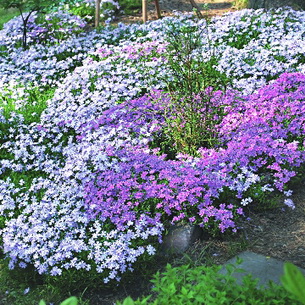
For open, windy or elevated places, the shortest phlox are suitable, with strong stems and a compact bush.
In sunny areas, varieties that are resistant to flower fading and powdery mildew will look especially impressive.
When choosing a place for planting variegated phlox, it is important to remember that the original color is fully manifested only under good lighting conditions. However, under the influence of the midday sun on variegated phlox, leaf burns are often observed, sometimes the leaves even bend or wrinkle.
See how phlox can be used in garden design in the photo, which offers different options for flower beds:
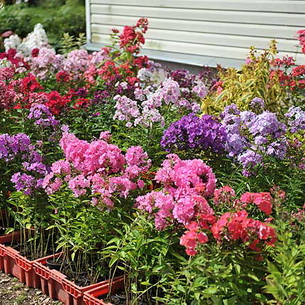
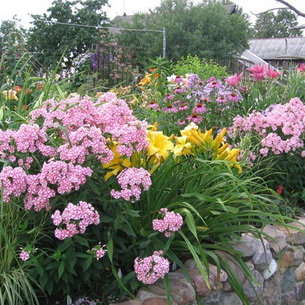
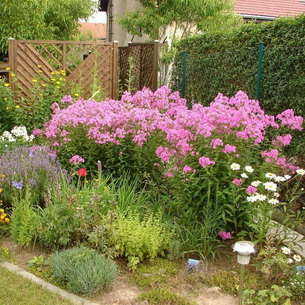
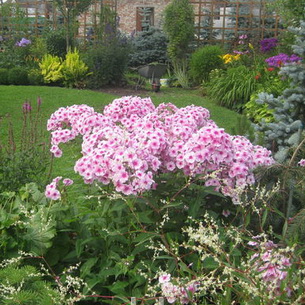
Bearded irises
Bearded irises are very common in landscape design. They combine several classes and are the largest group. They differ in height, which must be taken into account when using them in landscape design.
The creation of a radarium in the garden is very interesting. This is a flower garden that is built on a composition from one culture. Its dimensions correspond to the size of an average flower bed.
Irises are in demand in garden landscaping. With the right combination of iris, your garden design can be completely transformed. Several varieties of irises of different colors can be placed in the iridarium. Landings are carried out in groups, the gap between them is filled with small pebbles. At the same time, do not forget to leave free space, which overgrown plants will fill as they grow.
Important! Plants are not recommended to be planted in rows; it is better to plant asymmetrically, like on an alpine slide. Borders can be either indistinct or limited by stones of various sizes
Borders can be either indistinct or limited by stones of various sizes.
Interesting. The iridarium will look harmonious even on a retaining wall.
You can supplement such a flower garden with cereals, but you should not be zealous, 2-3 groups of cereals are enough. Ceramics or various forging are used as decoration for the iridarium. These can be vessels of various shapes, original benches and bridges, carved fence.
How beautiful to plant irises? Additional decorations of the iridarium are very important - the period of flowering of irises is not very long. The rest of the time, the flower garden will simply delight the eye with greenery. Therefore, the introduction of additional elements is necessary.
Bearded irises are striking in their beauty and diversity - they can be either one-color or two-color, two-tone, iridescent and edged. With their help, it is easy to decorate the landscape, creating a bright flower garden out of it.
Flower bed design schemes
By choosing different plants, combining them, you can create an almost endless number of variations of a simple but very effective flower bed. But if you are new to this business, then it will be easier to use ready-made options and simple schemes for creating flower beds.
- Central flower bed - this scheme is the easiest to organize a flower garden. It consists of circles. The center is filled with cannes with dark leaves, which are the soloists of the whole composition, then green-leaved cannes are planted in a circle, the third row is decorative leaf gnafalium and this parade ends with snapdragons.
- Vienna flower. To create such an option, you will need to organize a six-leafed flower on the flower bed, the center of which will be white levkoi, the border for which will be Alpine forget-me-nots. The outer edge is well organized with islands of viola, zinnia, primrose.
- A whimsical pattern is a round flower bed, which is decorated with a large number of undulating elements, decorated with variegated, sun-loving perennials. In the center of such a flower bed, you can place a squat chamerops with a beautiful crown of fan leaves. Its shadow will be a good background for dahlia zinnia, and coleus will act as a contrast. Fancy curls can be created with begonias and pelargoniums, which will look very impressive against the backdrop of lawn grass.
How else can irises be used in garden landscaping?
Designers willingly create single garden compositions - solitaires - from these luxurious, unpretentious flowers. For group planting, irises of the same type are usually taken, but in different shades. They can be placed against the background of a lawn or ornamental shrub that does not bloom. A composition of varieties that differ in height looks good.
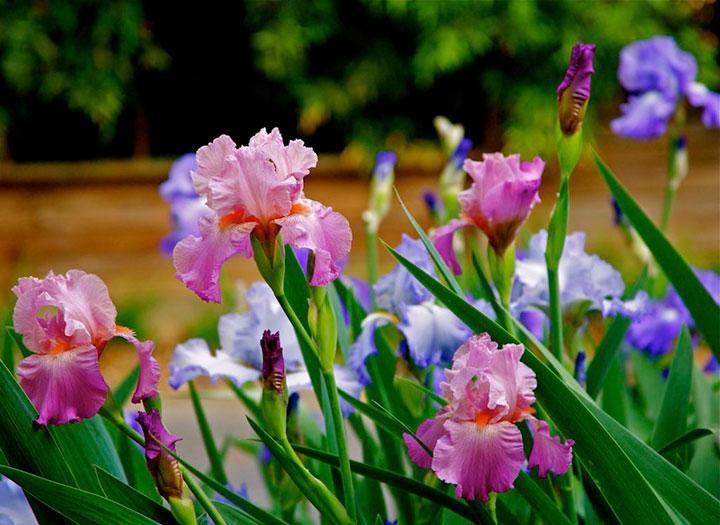
Another good option for using irises in landscape design is the design of a slide or rockery. For this purpose, it is best to plant miniature varieties. They combine saxifrage, stonecrop, crocuses, small tulips and creeping phlox. Flowers of a dark palette (brown, burgundy, deep purple) can be combined with light decorative stones. Yellow, blue irises should be planted against the background of creeping juniper.
The swamp or Siberian variety of perennial culture is an excellent addition to a natural or artificial pond, lake. A cozy place to relax is decorated with pebbles or gravel. The completeness of the garden composition will be given by the thuja, against which the irises are planted. Also, these flowers are good for decorating ridges, borders. They can be combined with other crops or used in monoplants.
When choosing perennial varieties by shade or height, consider the conditions for their cultivation. Not all irises can be combined with each other in the same area.
What are the types of irises and how they differ
Rhizome plants are perennials. Many flower hybrids have been bred. In addition to the color of the petals, they differ from each other in size, flowering time, and soil requirements. There are 2 types of garden culture.
p> All types of irises differ in the color of the petals. There are solid colors or colors of different saturation. Some have different shades of petals. Beautiful iridescent inflorescences, decorated with a contrasting border. A feature of the species is the superficial root system, the constant movement of plants as they grow. Bearded hybrids are widely used in flower beds, mixborders, and flower beds.
A group of beardless plants has a similar structure of petals, without hairs, but decorated with bright spots. The color of wild species is yellow. And this color remains dominant in many varieties. Hybrids were bred with purple, blue, white colors.

Requirements for the growing conditions of ornamental crops are different. Therefore, when planting irises in flower beds, the characteristics of each variety are taken into account.


